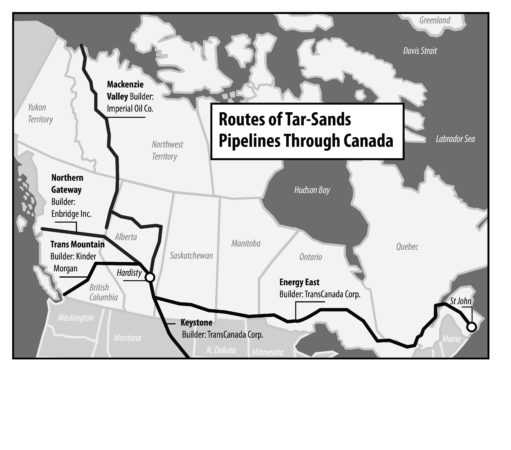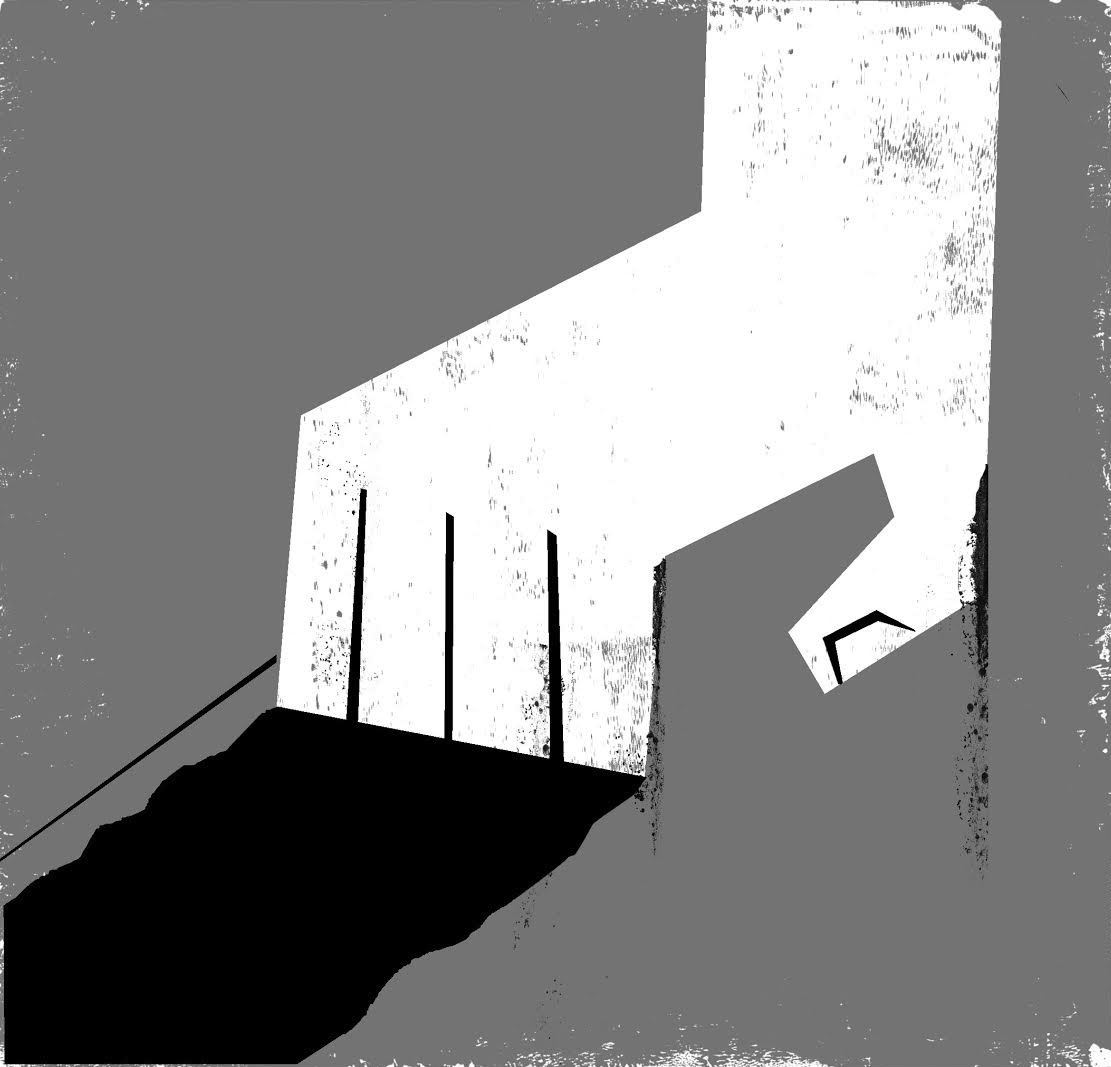Late 21st-century graduate students of business studying the growing problem of stranded assets will almost certainly focus on the history of Canada’s Athabasca Oil Sand (aka tar sands). The case studies they read will either describe the gradual abandonment of the world’s largest reserve of bituminous crude or they will read about the tar sands’ miraculous last-minute escape from becoming the world’s largest stranded asset. For either outcome, the turning point they will look back on is just about now.
In some respects Alberta’s gigantic deposits of bitumen, a dense mixture of sand and heavy crude oil, third in size only to the reserves of Saudi Arabia and Venezuela, were stranded from the start by location. Situated in the heart of a vast boreal forest at the center of a very large continent, they are hundreds of miles from the nearest refinery and thousands more from navigable tidewater.
If Canada’s oil sands do one day become stranded, the equivalent annual emissions of over 65 coal-fired plants and 50 million passenger vehicles will remain underground.
Of course, some of Alberta’s crude has made its way to market, but so much slower than it could have, or was projected to, that producers, refiners, shippers, banks and other investors in tar-sands development are beginning to wonder whether they have backed a good play by investing over $160 billion to turn tar into oil.
So the economic stranding process has already begun. Five global energy giants—Shell, Total, Suncor, Statoil and Occidental—have cut bait on major bitumen deposits in Alberta, in which they had already invested billions. Suncor has just slashed another billion dollars from its capital spending program and $800 million more from operating expenses. And as oil prices slide lower, commercial and investment banks are reconsidering future underwritings. An industry that recently envisioned doubling production over the next 20 years is now looking at something closer to the opposite, a halving of production or worse in far fewer than 20 years.
American media coverage of the tar sands has focused primarily on the approval of the Keystone XL Pipeline, which, if completed, would carry 830,000 barrels of Athabasca crude, every day, to the world’s largest refining center near Houston next to a booming export hub. Because American and Canadian politicians and oil execs have lobbied so hard for its approval, Americans tend to believe that construction of Keystone will secure the future of the tar sands. Not true. To even approach break-even, at least four other pipeline routes will be needed to carry bituminous crude to the world’s market: two to the Canadian west, one to the east and one north. If two or three of those lines are somehow stopped, and that’s quite likely to occur, the stranding of the tar sands will escalate, Canada will cease being a petro-state, and its business leaders will begin their search for yet another staple to drive its national economy.
Staples Economy
Canada has always been what economists call “a staples economy,” reliant almost completely on one staple resource after another. Fur was followed by cod, then wheat, potash, minerals, timber, and hydropower. Today, Canada’s staple resource is carbon, some of which derives from coal but most of it from oil. Oil, in fact, represents 46 percent of Canada’s commodity production. Unfortunately, over 90 percent of its reserves are bitumen, the costly production of which nets only 4 percent to Canada’s GDP. But oil represents 40 percent of the country’s exports. So the urgency to develop and export the tar-sands oil has become a national priority.
Canada’s tar-sands booster-in-chief is Prime Minister Stephen Harper, an Alberta-based petrolero who rose to prominence in politics as Chief Policy Officer of the Reform Party, Canada’s version of the American Tea Party. Founded in 1987, Reform merged in 2000 with the floundering Progressive Conservative Party to form a new and almost unbeatable national coalition calling itself the Canadian Conservative Reform Alliance (after adding “Party” to its name, it became CCRAP, and was nicknamed “see-crap”). Harper became party leader of CCRAP, which has since won two national elections. It’s as if Ted Cruz became the Republican front-runner and won the White House twice.

Map by Kevin Kreneck
Once a member of Canada’s Young Liberals and a supporter of Pierre Trudeau, Harper went west as a young man, worked in Alberta’s oil fields and followed his father into employment with Imperial Oil, Canada’s second-largest petroleum company (69 percent owned by ExxonMobil). There, like so many other western Canadians, he grew to despise Eastern Canada, rather like the scion of a prominent American family moving from Connecticut to Texas. In Calgary, he became an outspoken and eloquent opponent of Trudeau’s National Energy Plan, which seemed set upon nationalizing Canada’s last staple resource. While there is still talk of nationalizing oil and tar-sands oil in Canada, and in some polls a majority of Canadians support the idea, that couldn’t possibly happen with Harper in power.
At the 2012 World Economic Forum, in Davos, Switzerland, Harper announced that the expanded production and export of tar-sands bitumen was a national priority. Canada, he predicted, was set to become an energy superpower. In Ottawa, he took immediate and aggressive steps to weaken environmental protections like the Navigable Waters Protection Act, which was hindering pipeline construction, and to fast-track tar-sands production.
But Harper’s focus remained on Europe, where in 2012 the European Parliament and member European Union governments were debating terms of a revised Fuel Quality Directive (FQD) and considering an official ban on the import of “dirty fuels”—oil shale, liquid coal and tar sands, all of which have high extraction impacts, releasing more greenhouse gas than conventional oil through their “well to wheel” life cycle. A Stanford University study that many members of the EU Parliament relied on projected a 23 percent increase of lifecycle carbon emissions from tar-sands production.
Harper and his advisers immediately saw the danger of that study and the disaster a European ban on dirty fuel represented for Canada’s largest new staple. One vote in Brussels could leave the tar sands stranded immediately and forever, even if oil producers found a route to the Chinese market.
During the two years leading up to the EU parliamentary vote on the issue, Harper mobilized Canadian oil executives and his cabinet behind a $30 million nation-to-nation lobbying effort. Their first target was the Stanford study, which they drove into the ground with their own industry-funded studies.
Week after week, planeloads of oil execs and PR flacks crossed the Atlantic, Harper aboard whenever he could be, laterally threatening a trade war with Europe if the vote went the wrong way. Side trips were made to Washington. And members of the European Parliament were flown to Ottawa and Alberta for gold-plated junkets.
Without Harper’s effort, the Parliament in Brussels would almost certainly have voted to ban dirty fuels. After two years of intense lobbying, the measure lost by a 12-vote margin 337 to 325, with 48 abstentions. A few months later, in the fall of 2014, the first shipment of tar-sands crude arrived in Europe, with many more to follow, as a vote on the Fuel Quality Directive will not come up again for at least four years.
In the meantime, if a few EU member nations condemn tar-sands oil, and ban its import, more small nails will be driven into the tar-sands coffin. And if two of the proposed source-to-port pipelines on the drawing boards are blocked (see map and sidebar here), more producers and investors will abandon the sands.
If Canada’s tar sands do one day become stranded, the equivalent annual emissions of over 65 coal-fired plants and 50 million passenger vehicles will remain underground. And a lot of the credit (or blame) will go to environmental activists, aboriginal communities, litigious farmers and groups like Greenpeace, NRDC and 350.org, who have added to their anti-pipeline advocacy a campaign to pressure institutional investors to divest their “Big Fossil” holdings. Even before divestment began, nine of 10 tar-sands producers’ stocks had underperformed the market. So they are vulnerable.
Strand Their Capital
According to the Institute for Energy Economics and Financial Analysis, a think tank in Cleveland, the campaigns of environmentalists and native communities have already cost tar-sands producers $17 billion. But that has not stemmed the determination of the North American fossil-fuel industry to move Athabasca crude to refineries around the world.
Despite the insistence of American Republicans and petroleros that everything rests on completion of Keystone XL, the pipeline means little to the U.S. economy. In Canada, however, economists estimate that U.S. rejection of the pipeline could cost the country as much as $1.7 billion a year, far more significant than the loss of two or three hundred permanent jobs the pipeline would create in the U.S. And by simply raising break-even higher than it already is for bitumen producers, stopping Keystone could place the tar sands in far greater danger of being stranded.
While assets like the tar sands should be stranded, because mining and burning them will raise the temperature of an already overheated planet a degree or more, they are more likely to become stranded, because they are either unable to reach market or have lost market value.
The sad irony is that before Canada selected tar-sands crude to be its staple export, the country was poised to become a major global contributor to clean energy. It had signed climate treaties, promoted solar-energy, developed hydroelectric power and had a prosperous renewable-energy industry under sail, for which the country possessed all the necessary natural and financial resources. Then one powerful neoliberal free-market zealot decided to double down on high-carbon fuels and announce to the world that tar sands would become the next nation-building staple for his country.
It appears he was wrong about that, which would not be a bad outcome for the planet.
Journalist Mark Dowie is the author of Conservation Refugees: The Hundred Year Conflict Between Global Conservation and Native People.




